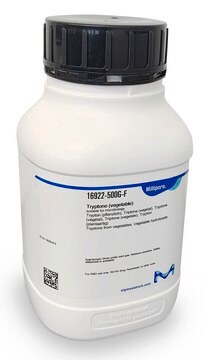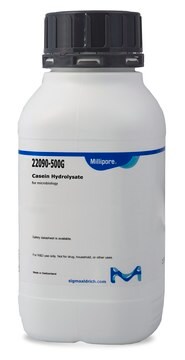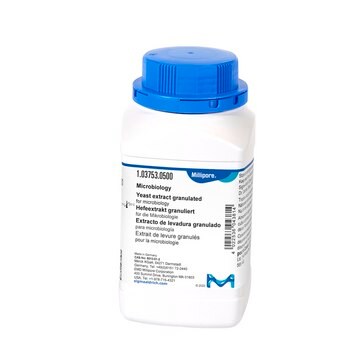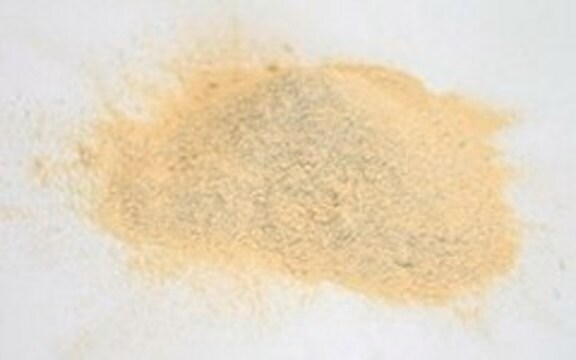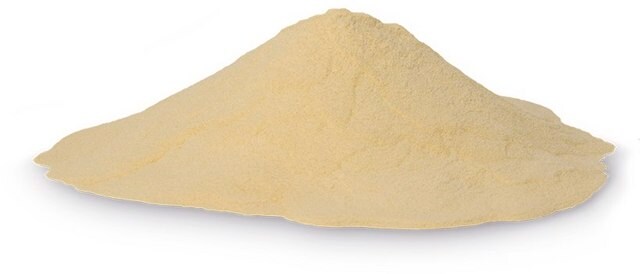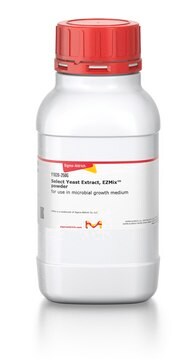T7293
Casein Peptone
Enzymatic digest of casein from bovine milk, 11.0-16.0% total nitrogen, suitable for biotechnology and microbiology
Synonim(y):
Peptone from casein, Peptone from casein, Pancreatic digest of casein., Tryptone
About This Item
Polecane produkty
product name
Tryptone, Microbiologically tested.
pochodzenie biologiczne
bovine milk
Poziom jakości
Postać
powder
jakość
Microbiologically tested.
opakowanie
bottle of 1 kg
bottle of 250 g
analiza azotu
11.0-16.0% total
strata
≤6% loss on drying
kolor
light yellow
pH
6.9-7.4
Zastosowanie
food and beverages
microbiology
przydatność
Escherichia coli
Haemophilus spp.
Lactobacillus spp.
Streptococcus spp.
coliforms
Szukasz podobnych produktów? Odwiedź Przewodnik dotyczący porównywania produktów
Powiązane kategorie
Opis ogólny
Zastosowanie
- Growth media: Tryptone is frequently used as a source of nutrients in growth media for bacteria, yeast, and other microorganisms. It can be used alone or in combination with other ingredients, such as agar, glucose, and salts, to provide a complete nutrient source for microbial growth
- Enrichment media: Tryptone is often added to enrichment broths to enhance the growth of slow-growing or stressed bacteria in clinical or environmental samples. This is particularly useful for samples where the target microbe is present in low numbers or is difficult to isolate
- Production of recombinant proteins: Tryptone is a component of many bacterial growth media used to produce recombinant proteins. It provides a rich source of amino acids and peptides, which are needed for protein biosynthesis
- It is also used in microbiological testing to determine the minimum inhibitory concentration (MIC) of antimicrobial agents against test organisms.Overall, the diverse and versatile properties of Tryptone make it a valuable tool in various microbiological applications
Uwaga dotycząca przygotowania
Kod klasy składowania
11 - Combustible Solids
Klasa zagrożenia wodnego (WGK)
WGK 1
Temperatura zapłonu (°F)
Not applicable
Temperatura zapłonu (°C)
Not applicable
Środki ochrony indywidualnej
Eyeshields, Gloves, type N95 (US)
Wybierz jedną z najnowszych wersji:
Masz już ten produkt?
Dokumenty związane z niedawno zakupionymi produktami zostały zamieszczone w Bibliotece dokumentów.
Klienci oglądali również te produkty
Produkty
Podłoże hodowlane zapewnia środowisko z odpowiednimi składnikami odżywczymi, źródłami energii i określonymi warunkami środowiskowymi dla wzrostu mikroorganizmów. Składniki podłoża hodowlanego obejmują zarówno cukry proste, jak i peptony, sole, antybiotyki i złożone wskaźniki.
Nasz zespół naukowców ma doświadczenie we wszystkich obszarach badań, w tym w naukach przyrodniczych, materiałoznawstwie, syntezie chemicznej, chromatografii, analityce i wielu innych dziedzinach.
Skontaktuj się z zespołem ds. pomocy technicznej


